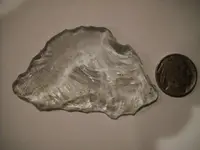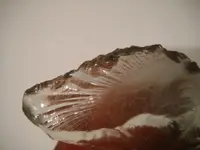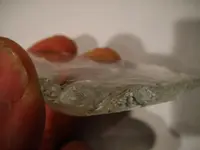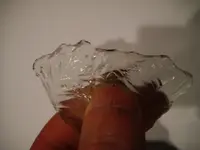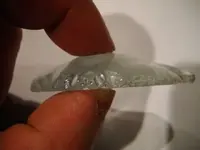Looks like lead glass from the pics.
Not produced in the Colonies until early 1700's.
Not likely Native American.
Could it have been melted?
From Wiki:
A very important advance in glass manufacture was the technique of adding lead oxide to the molten glass; this improved the appearance of the glass and made it easier to melt using sea-coal as a furnace fuel. This technique also increased the "working period" of the glass, making it easier to manipulate. The process was first discovered by George Ravenscroft in 1674, who was the first to produce clear lead crystal glassware on an industrial scale. Ravenscroft had the cultural and financial resources necessary to revolutionise the glass trade, allowing England to overtake Venice as the centre of the glass industry in the eighteenth and nineteenth centuries. Seeking to find an alternative to Venetian cristallo, he used flint as a silica source, but his glasses tended to crizzle, developing a network of small cracks destroying its transparency. This was eventually overcome by replacing some of the potash flux with lead oxide to the melt.[42]
He was granted a protective patent in where production and refinement moved from his glasshouse on the Savoy to the seclusion of Henley-on-Thames.[43]
By 1696, after the patent expired, twenty-seven glasshouses in England were producing flint glass and were exporting all over Europe with such success that, in 1746, the British Government imposed a lucrative tax on it. Rather than drastically reduce the lead content of their glass, manufacturers responded by creating highly decorated, smaller, more delicate forms, often with hollow stems, known to collectors today as Excise glasses.[44] The British glass making industry was able to take off with the repeal of the tax in 1845.



